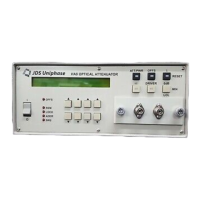Programming Guide – 51
• Each response message can contain multiple pieces of data. Data within a response
message is separated by a comma, for example, the query *IDN? returns
JDS UNIPHASE,HA9X,0,YY.YYY.
Overview of Implemented Status Structures
There are three distinct status data structures implemented in the attenuator:
• IEEE 488.2-defined standard registers (standard status structure)
• SCPI-defined operation registers (operation status structure)
• SCPI-defined questionable registers (questionable status structure)
The standard status structure consists of four registers:
• Status byte register
• Service request enable register
• Standard event status register
• Standard event status enable register
The operation and questionable status structures are identical except for the use of specific
bits. These status structures are each composed of five registers:
• Condition register
• Positive transition register (PTRansition)
• Negative transition register (NTRansition)
• Event register
• Event enable register
The bits in the operation status structure reflect a specific condition within the attenuator. The
attenuator only uses bit 1 of the operation registers. Bit 1, the settling bit, is set when the
attenuator is in the process of adjusting the attenuation.
The bits in the questionable registers give an indication of the quality of the output of the
attenuator. None of the bits in the questionable register are currently used by the attenuator.
All three status structures are connected by the status byte register. Figure 13 and Figure 14
show the relationship between the registers.
Artisan Technology Group - Quality Instrumentation ... Guaranteed | (888) 88-SOURCE | www.artisantg.com

